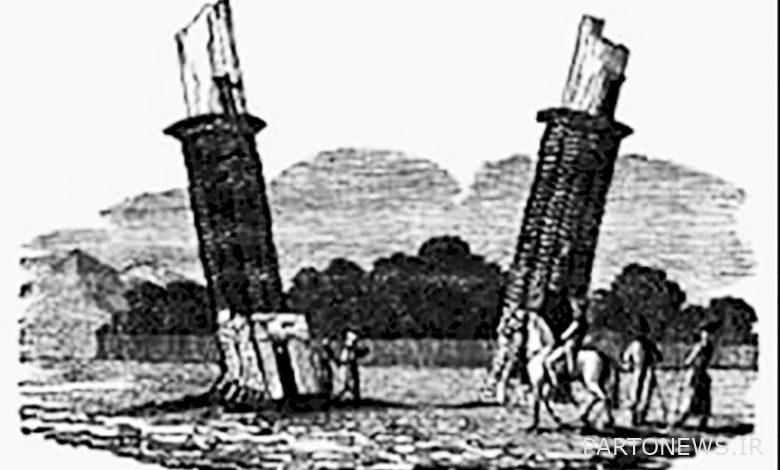Reading the report of James Moreau from the tomb and minarets of Shams Tabrizi in Khoy

James Justinian Moreau, Secretary of the British Embassy during the reign of Fath Ali Shah, observed and recorded the tomb and minarets of Shams Tabrizi twice during his passage through Khoy. Miley Khoi, a very large collection of houses and gardens, has built a neighborhood of the city where many people live, a water stream that rises from the mountains flows in this neighborhood and on the northern slopes there are two brick pillars called the tomb of the poet. “And the famous scientist is the mullah of Tabriz named Shams.” (Morier, 1812: 300).
Moriah’s report on the geographical location of the Shams Tabrizi minarets on the way from Khoy to Pereh (Firurq) corresponds to the characteristics of Shams Tabrizi’s tomb and its only surviving minaret northwest of Khoy in a neighborhood called Imamzadeh neighborhood and an alley called Shamishudibi (near Shams). Although he mistakenly and probably according to the information of public rumors, has considered Shams Tabrizi a poet.
On his second voyage on June 1, 1814, James Moreau returned to Khoy, and after describing the unique features and beauties of the Khoy plain, described his visit to the minarets of Shams Tabrizi as follows: Ishmael is gone. It is said that King Ishmael hunted a large number of wild goats one day and, at his command, placed their bowls of horned heads around these two brick pillars. “Goats and antelope herds are said to be so numerous in the northern mountains of Khoy that they are outnumbered, both towers of the minaret have tilted from their original position, and another severe earthquake will undoubtedly bury them all at once.” (Morier, 1818: 305-306).
In his second trip, in addition to describing the minarets of Shams Tabrizi, Moreiyeh also drew a picture of them.
Examining the drawing by James Moriah, the following findings are noteworthy: Given the appearance of the main opening of the spire and the entrance to the minarets, which are designed to the south and west, it seems that Moriah’s view angle is northward and probably from the south angle. It was west-northeast.
Moriah’s painting confirms that the two existing minarets at that time were not very far from each other. According to the scale used in the height of the minaret and the height of the people drawn, it seems that the distance between the two minarets was about 5 to 6 meters.
To confirm this idea, archeological excavations can be carried out at a distance of 5 to 6 meters to the north of the existing minaret. The north has been angled. With these descriptions, it can be concluded that the left minaret has been destroyed and the right minaret has remained to this day.
Given the angle of inclination drawn by Moriah, it seems that the slope of the minarets has not changed much since 205 years ago, and Moriah’s prediction that they would collapse due to a possible earthquake has only come true for the minaret on the left.
Moriah’s painting shows that the skulls of wild animals are located in the middle of the minaret and are not seen in the upper parts (above the saucer-like protrusion) and in the lower parts (slightly above the entrance of the minaret).
The photo of Ali Khan Wali as the oldest recorded image of the minaret is also a confirmation of this idea.
In his report, Moreau attributed these branches to wild goats and antelopes, which the authors’ study examined the correctness of this statement.
Morea’s realism has cast doubt on King Ismail’s hunting of thousands of wild animals in one day. , 1375: 517) which is closer to reality in terms of number but in terms of the type of wild animals used in the minaret, this statement also needs to be examined.
The fact that Moriah mentions the tomb of Shams Tabrizi in his first travelogue, but no special structure can be seen in the painting drawn by him, confirms the idea that on that date, apart from the minarets, other relics of the tomb of Shams Tabrizi are visible, which are visible in the drawing of Motaraghchi. His reference to the tomb or burial ground of Shams Tabrizi also confirms this idea. In the image of Morea, a wall is drawn around the area where these minarets are located, behind which garden signs can be seen, which may be the remnants of the royal garden.
The report of James Moreau on his second visit in June 1814 (June 11, 1193 and 12 Jamadi al-Thani 1229 AH) shows that there were still two minarets in those years, on the other hand, the report of Ali Khan Wali in 1297 AH. By recording the image of only one minaret and using the singular pronoun in its subtitle, AH shows that in this distance, another minaret has been destroyed and only one of them remains.
Therefore, some statements that the second minaret collapsed during the First World War can not be true (Riahi, 1375: 531).
Jahangir Mirza of Qajar in the margins of the works of Al-Balad and Akhbar Al-Ebad in 1268 AH. AH points to the existence of two minarets from the hunting lodge, this report shows that until 39 years after the observations of James Moreau, the second minaret remained and its destruction between 1268 and 1297 AH. AH has occurred.
* Report by Reza Bayramzadeh, a graduate of Ancient Iranian Art History
.

